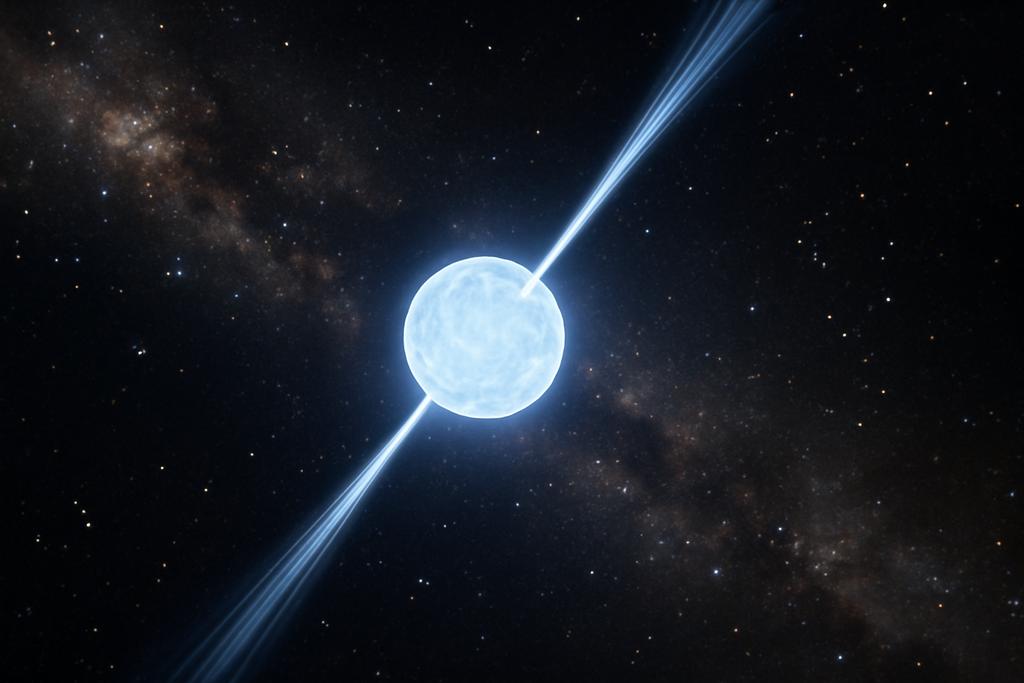Imagine a spinning top, perfectly balanced, its axis unwavering as it whirls. Now, picture that top made of the densest material in the universe, riddled with magnetic fields stronger than anything on Earth, and subject to immense gravitational forces. This is a neutron star, and according to new research, these cosmic objects aren’t quite as stable as we once thought.
What’s Wobbling in the Cosmos?
Neutron stars are the ultra-dense remnants of massive stars that have exploded as supernovae. Cramming more mass than our sun into a sphere the size of a city, they possess incredible properties. Many are also pulsars, emitting beams of radio waves or other radiation that sweep across our sky as they rotate, like a cosmic lighthouse. For decades, scientists have studied these pulsars, meticulously measuring their spin rates and magnetic fields, slowly piecing together the story of their lives and deaths. But there’s a twist: these stars aren’t perfectly spherical, and they’re also subject to magnetic forces that change over time. This is where the “wobbling” comes in.
A new study from Tel Aviv University suggests that even the tiniest imperfections in a neutron star’s shape, combined with its powerful magnetic field, can cause it to wobble, or precess, as it spins. This precession, the researchers found, significantly affects how these stars evolve, influencing everything from their observed spin rates to the angles at which they emit radiation. The research team, led by Anton Biryukov, Pavel Abolmasov and Amir Levinson, developed a detailed model to explain these complex interactions.
Free to Precess
Think about a spinning coin. When it’s perfectly upright, it spins smoothly. But as it slows and starts to tilt, it begins to wobble noticeably – that’s precession. In neutron stars, this wobbling arises from a combination of factors. First, neutron stars aren’t perfect spheres. They can have slight deformations in their crust, the rigid outer layer. These deformations might be caused by the immense pressures within the star, uneven heating, or the star’s powerful magnetic field contorting its shape. Second, the magnetic field itself isn’t perfectly aligned with the star’s rotational axis. This misalignment creates a torque, a twisting force, that further contributes to the precession.
The team’s models took into account both these factors: the star’s deformation and the magnetic torque, alongside the gradual decay of the star’s magnetic field, and found that these wobbles aren’t just minor perturbations. They can dramatically alter the star’s long-term evolution. What’s more, they found that the interplay between pulsar torques and free precession can naturally explain the observed distribution in pulsar braking indices by creating a periodic oscillation in the magnetic obliquity.
The Obliquity Twist
One of the key concepts in the study is magnetic obliquity: the angle between a neutron star’s rotational axis and its magnetic axis. If neutron stars were perfect spheres spinning in a vacuum, you’d expect the magnetic and rotational axes to gradually align over time. But observations show a wide range of obliquities, from nearly aligned to almost perpendicular. This is where the new model shines. It shows that precession can prevent this alignment, maintaining a diverse population of neutron stars with varying magnetic angles. Imagine a disco ball – the light shoots out at all angles. These wobbling stars can emit radiation in many directions, affecting how we see them from Earth.
Braking Badly
Another puzzle the model addresses is the strange behavior of “braking indices.” As pulsars spin down, their rotation rates decrease. The braking index is a measure of how quickly this slowdown occurs. For a simple, isolated pulsar, the braking index should be around 3. But observations reveal braking indices all over the map, including many negative values, some reaching as high as a million. These are anomalous braking indices. The Tel Aviv team demonstrated that precession can cause these anomalies by creating periodic oscillations in the magnetic obliquity. Think of it like this: the wobble introduces a long-term cyclic component, leading to drastically different braking indices depending on the observation window.
Why This Matters
This research has significant implications for our understanding of neutron stars and pulsars. By incorporating the effects of precession, we get a more accurate picture of how these stars evolve, how they emit radiation, and how their properties change over time. This understanding isn’t just about filling in the blanks in our astrophysics textbooks; it also has broader implications for our understanding of the universe.
Neutron stars are cosmic laboratories, offering insights into the behavior of matter under extreme conditions. They’re also potential sources of gravitational waves, ripples in spacetime that can tell us about the most violent events in the cosmos. A better grasp of neutron star dynamics helps us interpret these gravitational wave signals and probe the fundamental laws of physics. Imagine tuning into a cosmic symphony – understanding the nuances of neutron star behavior helps us decipher the music of the universe.
Fluid Dynamics
It’s important to note that the model described in the paper treats the neutron star as a solid body, where in reality, the interior of the star contains a neutron superfluid component. This superfluid interacts with the crust and solid parts of the interior. While the model ignores the effects of this interaction, the authors note that a full treatment of the spin evolution of neutron stars would need to take the interaction of the crust, core, and superfluid into account.
The Bigger Picture
This isn’t the final word on neutron star dynamics. Future research will undoubtedly refine the models, incorporating more detailed physics and comparing the predictions with ever-improving observational data. But the study is a crucial step forward, reminding us that even the most seemingly stable objects in the universe can have hidden complexities. These wobbling neutron stars offer a new perspective on stellar evolution, high-energy astrophysics, and fundamental physics. It’s a cosmic reminder that even in the most extreme environments, things are rarely as simple as they seem.










